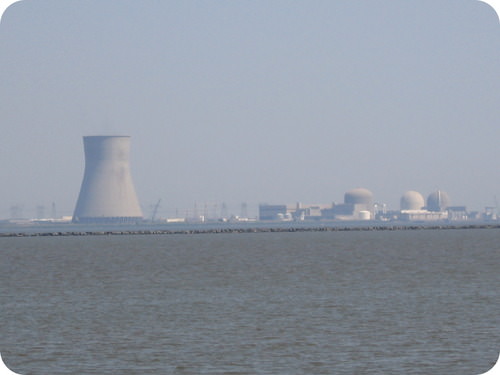16.5 溶性
章节大纲
-
What happens to the fish in the water next to a nuclear power plant?
::核电厂旁边的水里鱼怎么办?plants require large amounts of water to generate steam for the turbines and to cool the equipment. They will usually be situated near bodies of water to use that water as a coolant, returning the warmer water back to the lake or river. This increases the overall temperature of the water, which lowers the quantity of dissolved oxygen, affecting the survival of fish and other organisms.
::工厂需要大量水来为涡轮机产生蒸汽,并冷却设备,通常在水体附近,将水用作冷却剂,将暖水还回湖或河流,这增加了水的总体温度,降低了溶解氧的数量,影响了鱼类和其他生物的生存。How Temperature Influences Solubility
::温度如何影响溶性The solubility of a substance is the amount of that substance that is required to form a saturated solution in a given amount of solvent at a specified temperature. Solubility is often measured as the grams of solute per 100 g of solvent. The solubility of sodium chloride in water is 36.0 g per 100 g water at 20°C. The temperature must be specified because solubility varies with temperature. For , the pressure must also be specified. Solubility is specific for a particular solvent. We will consider solubility of material in water as solvent.
::物质的溶解度是指在特定温度下以一定数量的溶剂形成饱和溶液所需的物质量,溶解度通常以溶液克/100克溶剂测量,在20°C时,水中氯化钠的溶解度为36.0克/100克。由于溶性随温度变化而必须规定温度。对于压力也必须规定。溶解度是特定溶剂所特有的。我们将考虑将水中材料溶解性作为溶剂。The solubility of the majority of solid substances increases as the temperature increases. However, the effect is difficult to predict and varies widely from one solute to another. The temperature dependence of solubility can be visualized with the help of a solubility curve , a graph of the solubility vs. temperature (see Figure ).
::大多数固体物质的溶性随着温度的上升而增加,但这种效应难以预测,而且从一个溶液到另一个溶液之间差异很大,溶性对温度的依赖在溶性曲线(溶性与温度之比图)的帮助下可以直观化(见图)。Solubility curves for several compounds.
::若干化合物的溶解性曲线。Notice how the temperature dependence of NaCl is fairly flat, meaning that an increase in temperature has relatively little effect on the solubility of NaCl. The curve for KNO 3 , on the other hand, is very steep and so an increase in temperature dramatically increases the solubility of KNO 3 .
::注意NaCl的温度依赖性如何相当平坦,这意味着温度的上升对NaCl的溶解性影响较小。 而KNO3的曲线则非常陡峭,因此温度的上升使KNO3的溶解性急剧增加。Several substances – HCl, NH 3 , and SO 2 – have solubility that decreases as temperature increases. They are all gases at standard pressure. When a solvent with a gas dissolved in it is heated, the of both the solvent and solute increases. As the kinetic energy of the gaseous solute increases, its molecules have a greater tendency to escape the attraction of the solvent molecules and return to the gas phase . Therefore, the solubility of a gas decreases as the temperature increases.
::一些物质 — — HCl, NH3, 和SO2 — — 的溶性随着温度升高而下降。 它们都是标准压力下的气体。 当溶气溶解的溶剂被加热时,溶剂和溶液都会增加。 随着气体溶液的动能增加,其分子更倾向于逃避溶剂分子的吸引力,回到气相。 因此,气体的溶性随着温度升高而下降。Solubility curves can be used to determine if a given solution is saturated or unsaturated. Suppose that 80 g of KNO 3 is added to 100 g of water at 30°C. According to the solubility curve, approximately 48 g of KNO 3 will dissolve at 30°C. This means that the solution will be saturated since 48 g is less than 80 g. We can also determine that there will be 80 - 48 = 32 g of undissolved KNO 3 remaining at the bottom of the container. Now suppose that this saturated solution is heated to 60°C. According to the curve, the solubility of KNO 3 at 60°C is about 107 g. Now the solution is unsaturated since it contains only the original 80 g of dissolved solute. Now suppose the solution is cooled all the way down to 0°C. The solubility at 0°C is about 14 g, meaning that 80 - 14 = 66 g of the KNO 3 will recrystallize.
::溶解性曲线可用于确定给定溶液是否饱和或不饱和。 假设在30°C时将80克KNO3添加到100克的水中。 根据溶解性曲线, 大约48克KNO3将在30°C时溶解。 这意味着溶液将饱和, 因为48克小于80克。 我们还可以确定在容器底部将存在80 - 48 = 32克未溶解的KNO3。 现在假设这个饱和性溶液为80 - 48 = 32克, 也就是说, KNO3在60°C时的溶液将加热到60°C。 根据曲线, KNO3在60°C时的溶解性大约为107克。 现在,溶液是不饱和的, 因为它只含有溶解溶解溶液的原80克。 现在假设溶液将一直冷到0.C。 0°C时的溶解性大约为14克, 这意味着KNO3的80 - 14=66克将重新固化。Summary
::摘要-
The solubility of a solid in water increases with an increase in temperature.
::水中固体的溶解性随着温度的上升而增加。 -
Gas solubility decreases as the temperature increases.
::随着温度的上升,气体溶解度会下降。
Review
::回顾-
Why does the solubility of a gas decrease as the temperature increases?
::为什么气体的溶解性会随着温度的升高而降低? -
Is the solubility of NaCl affected by solvent?
::溶剂是否影响纳氏溶解度? -
What is the solubility of KNO
3
at 50°C?
::50°C时KNO3的溶性如何?
-
The solubility of a solid in water increases with an increase in temperature.

